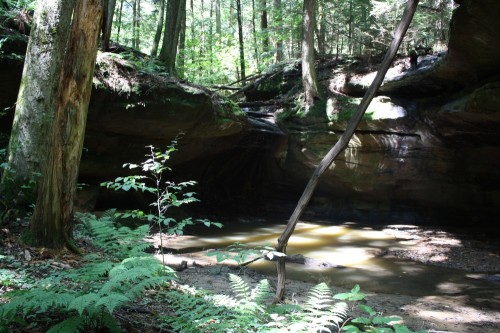The reason I wrote yesterday’s entry on Barefooted Mindfulness is because the day before I spent the time hiking, mostly bushwhacking, in Hocking Hills. And as I was doing so, I realized that I really wasn’t watching too carefully where I put my feet. That caused me to think about the stages of barefooting and just how much trust I was putting into my well-keratinized soles.
What do I mean by well-keratinized?
I’ve written about this before, but it doesn’t hurt to repeat it. When you continually put pressure on your skin, it (and particularly the skin on your soles) responds by dramatically increasing the keratin content of that skin. When the pressure is localized (because one spot of a shoe is rubbing it), we call it a callus, and it can get quite annoyring. But when it is spread over the whole foot, as it is for a barefooter, it is quite comforable, and that is how feet expect to be.
Keratin is the same substance that makes up fingernails and hair (and claws, and rhino horns, etc.). It really is quite protective. So that is why I wasn’t particularly worried.
The area I started out at had an old road that was quite overgrown with weeds, so I couldn’t see where I was putting my feet anyways. No big deal. Later, I got in under the tree canopy, and the forest floor was covered in rocks, leaf litter, broken branches and twigs, and understory plants. None of that really worried me, not even the occasional poison ivy. The keratin on my soles (along with their thickness) seems to keep it out, and simply brushing it with the sides of my feet doesn’t seem to release the urushiol.
So nothing worried me until I hit some stinging nettles. Now that bothered me. Stinging nettles have small needles that inject histamines and other chemicals, and it really, really itches. Of course, that wasn’t a problem for my feet, but for my legs since I was wearing shorts. I got out of there quickly.
Anyways, here are a few pictures I took down in Kline Hollow, where I was. Kline Hollow has two branches. This first photo is of the topmost waterfall and cave for the side, western branch, where I started out after leaving the overgrown road:
I then followed the creek to where it met the main branch, and headed up it. This is what you see as you approach its waterfall:
Here’s a closer look at the cave, and you can see where the channel is that has cut into the rock into the cave:
Now here’s that channel from the top:
To take that picture, I had to climb down into part of the channel, which is a real joy when barefooted. The rock here is sandstone with an interesting rough texture, and my soles could tell just how good of a grip I was getting on the rock while climbing down, and then back up.
And backing off just a bit, we can see where the water starts going into the channel:
And finally, backing up still farther, and you can also see the downstream scenery in the background:
One other thing I saw up there was some sort of fungus or non-chlorophyllic plant growing on a piece of rotting log. Here’s a picture:
And here’s a close-up:
If you recognize what that is, I’d sure like to know. [My thanks to Tim in the comments, who identified it as a sort of coral fungus.]
One thing I like about this bushwhacking is that I am seeing spectacular parts of the park that very, very few other people have ever seen. Most people restrict themselves to the (admittedly also spectacular) big name Hocking Hills locations: Cantwell Cliffs, Rock House, Conkles Hollow, Old Man’s Cave, Cedar Falls, and Ash Cave. But there is so much more that I get to see and explore by being willing to just wander around.
Finally, after all this bushwhacking in stage three, how are my soles? Pristine (though a bit dirty). No injuries at all.
I actually cannot quite say the same about my legs, which are scratched up a bit, as are a few locations on the sides of my feet. But that is just part of the ticket for enjoying the actual physical feel of all this terrain.









Bob,
I found your mystery fungus. That is called Coral Fungus or clavarioid fungi. It grows only on dead and decaying wood. Not exactly sure about the sub-species though.
http://en.wikipedia.org/wiki/Coral_fungus
Thanks, Tim. Nicely done.
Looking into it a bit further based on your tip, it might be either Artomyces pyxidatus or Ramaria stricta.
LOVE Hocking Hills area and have vacationed there the past two summers. Wonderful pics!